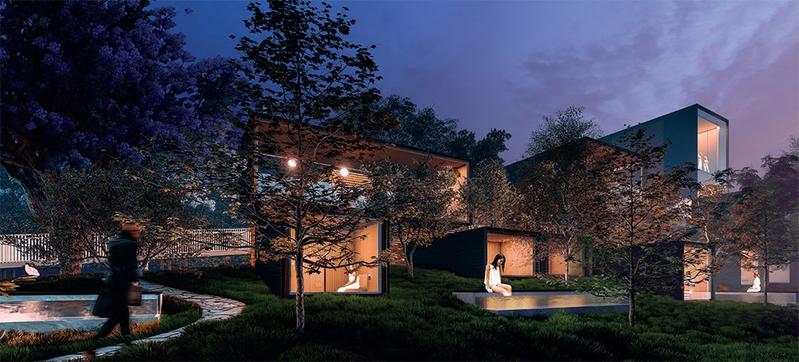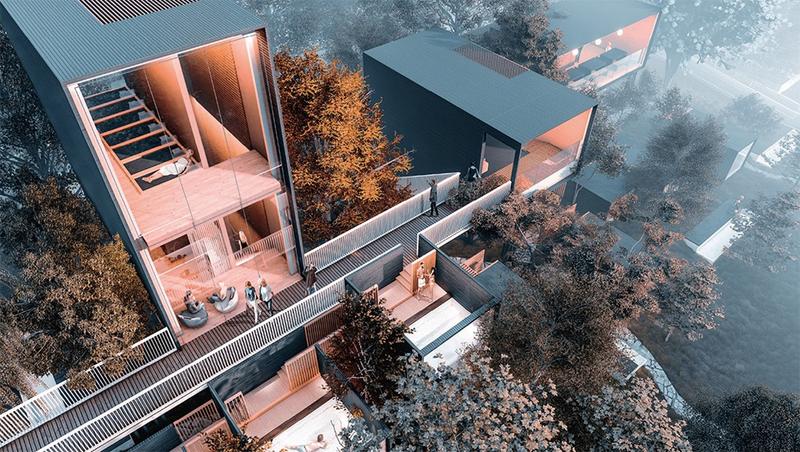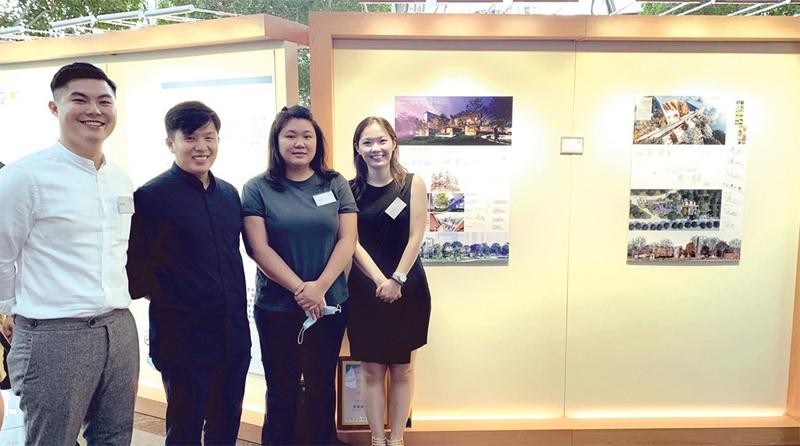 Simulations of Forest Bath, a leisure space designed by Leung Shun-ting and her team, in the Qianhai Shenzhen-Hong Kong Modern Service Industry Cooperation Zone. The houses, which will be completed in April, aim to provide a leisure space for financial and technology practitioners. (PHOTO PROVIDED TO CHINA DAILY)
Simulations of Forest Bath, a leisure space designed by Leung Shun-ting and her team, in the Qianhai Shenzhen-Hong Kong Modern Service Industry Cooperation Zone. The houses, which will be completed in April, aim to provide a leisure space for financial and technology practitioners. (PHOTO PROVIDED TO CHINA DAILY)
When architect Leung Shun-ting took a design field trip in 2019 to Qianhai, a coastal area under full-speed construction in Shenzhen, the 37-year-old architect immediately felt an ambience of a potential world-class business district — and along with it the same fast-paced, pressurized environment in Hong Kong, where she comes from.
Hong Kong professionals were among the first to help the mainland when it first opened up to the world in the 1980s, by assessing land and property in the newly created Special Economic Zone
Leung and her team participated in a competition, which is exclusively for professionals aged 45 and younger, to design a commercial leisure stop for the area. They thought they could help address the stressful atmosphere. Leung thought about how in Hong Kong, she would feel at ease every time she went hiking or breathed in the forests of Hong Kong’s sundry country parks.
Leung and her team designed their project with elements like wood and glass, as well as a bona fide Scandinavian sauna, so that people would enjoy a natural environment when they came to rest in their building away from those skyscrapers.
ALSO READ: Shenzhen makes strides in luring HK builders
The design won them first place in the competition in July. Since then, Leung has been feeling lucky and excited that her work would be part of Qianhai, a future regional service hub filled with banks, law firms and other high-tech companies.
Ample opportunities
Leung is one of many young architects in Hong Kong who have been offered jobs in the Guangdong-Hong Kong-Macao Greater Bay Area. With its vast territory and strong growth momentum, the mainland offers unprecedented development opportunities. With qualification policies and competitive bidding, those opportunities are shared with young professionals in Hong Kong.
In return, the young architects show what they have to offer: leading international ideas and practical design styles to help people in the region enjoy an advanced lifestyle.
It will be a win-win for sponsors and architects if the mainland initiatives open up for competition and hire the most outstanding candidates, said lawmaker Tony Tse Wai-chuen, who represents the city’s 9,000-strong professionals in the architectural, surveying, planning and landscape sector in the Legislative Council.
Competitions such as the one Leung participated in offer young people a great chance to make their creativity a reality, Tse said. Experience is the meaningful outcome that young people value the most, he said.
Tse was the coordinator between Shenzhen authorities and Hong Kong relevant professional institutions in Qianhai’s contest, which was initiated by the Liaison Office of the Central People’s Government in the Hong Kong Special Administrative Region. Tse said it was the second such competition offered exclusively to Hong Kong candidates and hopefully the second of many to come.
Opportunities do not come to young professionals in Hong Kong as effortlessly as they did 40 years ago, said Tse, who was a surveyor since the 1970s before entering politics.
 Simulations of Forest Bath, a leisure space designed by Leung Shun-ting and her team, in the Qianhai Shenzhen-Hong Kong Modern Service Industry Cooperation Zone. The houses, which will be completed in April, aim to provide a leisure space for financial and technology practitioners. (PHOTO PROVIDED TO CHINA DAILY)
Simulations of Forest Bath, a leisure space designed by Leung Shun-ting and her team, in the Qianhai Shenzhen-Hong Kong Modern Service Industry Cooperation Zone. The houses, which will be completed in April, aim to provide a leisure space for financial and technology practitioners. (PHOTO PROVIDED TO CHINA DAILY)
Hong Kong professionals were among the first to help the mainland when it first opened up to the world in the 1980s, by assessing land and property in the newly created Special Economic Zone. In 1987, Leung Chun-ying, who later become Hong Kong’s third chief executive, was a consultant for the first land auction in Shenzhen.
During the past four epic decades, mainland professionals have learned fast in all fields, and overseas practitioners have learned faster — about China. Naturally, Hong Kong’s traditional role as a liaison between the mainland and the rest of the world is fading, said Tse.
To compete with their mainland or foreign counterparts, Hong Kong’s young architects and surveyors must have a deep knowledge and understanding of the land they help develop, he said.
For landscape designer Mandy Kwok Siu-man, 27, it is both a challenge and an opportunity to have a growing demand for good landscape designs from the construction projects on the mainland. She needs to come up with a design of both environmental and commercial value to fit these cities’ new development plans, which focus on quality and sustainability.
For example, Kwok has participated in two major ecological projects in the Bay Area, river bank renovation projects for Tianmu River in Zhuhai and Maozhou River in Shenzhen. The projects, each costing more than 600 million yuan ($77.4 million), were part of the plan to turn the two cities into pilot “sponge cities”, a construction method that uses natural infrastructure for stormwater management.
Meanwhile, the river banks were also designed to serve as the cities’ new public leisure and entertainment districts and attract tourists and businesses with the view.
“Sustainable landscape design will add more value to an area and its vicinity, meeting both the public’s needs and the interests of the developer,” said Kwok.
Artistic inspiration
For example, US landscape architect Frederick Law Olmsted in the 19th century proposed vast public green spaces for New York City’s dwellers at the heart of Manhattan, after he reflected on the adverse impact of intensive urbanization on the health and wellness of the people at the time. Now, Central Park has become the spiritual and social core of the city.
Leung Shu-ting agreed with the idea, saying it is important to ensure harmony between human and Nature from the beginning of construction. Different natural elements, such as trees and rivers, need to be considered as much as buildings and facilities.
In her own designs at Qianhai, she delicately chose to plant in the courtyard blue jacarandas, which bloom splendidly in the spring, and ginkgo trees, which turn golden yellow in the autumn, so that people can feel the change of the seasons in a more dramatic way.
Architects know the architectural environment can influence people in subtle ways, in every detail, because they experience and notice such impacts all the time in their daily lives, said architect Paul Mui Kui-chuen, 42.
In 2010, he and his two teammates won the HK$450,000, first prize in the professional group of a government-funded competition on cross-boundary facilities for the regional century project Hong Kong-Zhuhai-Macao Bridge.
When conceiving the design, Mui recalled that it was rather a toilsome experience to cross the boundary from some checkpoints between Hong Kong and Shenzhen. Travelers had to queue in an unventilated concourse with little sunlight and walk a long way to get to city transportation.
He wanted those who used his facilities to find it pleasant and relaxing to move from city to city. It now takes only a few seconds to cross the boundary using an electronic channel between Shenzhen and Hong Kong, a minute at most, Mui said.
Signs and customs facilities apart, people could hardly notice they have entered another city, nor do they need to, Mui said, adding that modernized ports in the Bay Area are “also” a place where people meet each other.
The idea resulted in his prize-winning entry, titled “Under the Same Roof” which implies the integration of three different regions within one country. The jurors praised the work as “simple and functionally sound” and appreciated its comfortable welcoming with two beautiful courtyards at the arrival and departure zone and giant windows containing entire sea views including scattered islands and the bridge itself.
However, Mui’s design never became a reality, as the competition then was more a symbolic one in commemorating the significant project.
 Leung Shun-ting (third from left) and her colleagues win first place in a design competition for Qianhai Guiwan Park in Shenzhen in July. (PHOTO PROVIDED TO CHINA DAILY)
Leung Shun-ting (third from left) and her colleagues win first place in a design competition for Qianhai Guiwan Park in Shenzhen in July. (PHOTO PROVIDED TO CHINA DAILY)
A little pity, he acknowledged, but Mui said it is understandable because such large-scale construction naturally flows to larger architectural firms for their richness in people, resources, and experience.
Years later, his ideas proved to be a new trend. For example, Huanggang Port, which is under renovation, has adopted a ground park and green rooftop to make it more publicly accessible. The new port is set to be an iconic public space at the heart of the region after it opens in 2022.
Mui also said he looks forward to setting up a branch office on the mainland and expanding his business there. It is important for the architecture industry to have a representative who understands the local tax system and other policies to contend for a project and take over, he said.
Valuable experience
To facilitate these smooth collaborations, Tse suggested the governments in the Bay Area take the lead in sharing information so that architects could easily get familiar with local regulations, construction industries, and other requirements.
More importantly, architects themselves need to take the initiative to get the relevant information through practice, he said.
Young architects also find their hands-on experience on the mainland valuable and rewarding.
For landscape designers like Kwok, the available space, either physical or on paper, plays an important role in their designs. It allows more aggressive proposals on the mainland than in Hong Kong, where a certain tree can only be felled if it endangers property or life, is in poor health or there is no alternative for necessary development.
Mui, while he agreed that the mainland’s flexibility creates room for good design, said it doesn’t mean its requirements are more lax than in Hong Kong.
For example, to design a decorative screen for an art gallery in Chengdu, Sichuan province in 2018, he found that the city had strict and detailed anti-seismic regulations, which were not in place for most architecture back in Hong Kong.
For Leung, the unwritten rules matter just as much, like climatic conditions and local culture and customs. In 2009, as a new graduate taking on a project outside Hong Kong for the first time, she proposed a classical-style fountain on the square of a residential project in Tianjin.
The design was immediately rejected by the developers, who enlightened her that Tianjin is so cold in winter that every drop of water outside will freeze. It is never an issue in Hong Kong, which lies just within the tropics.
The experience reminded Leung that an architect must be humble and sensitive enough to customs elsewhere, especially for historical mainland cities where residents are deeply attached to the unique and settling vibe of their hometowns, as she later found. She developed a habit of observing whether locals prefer a breeze from drafty windows, or, like Hong Kong people, cannot live without a strong, tightly secured air-conditioning system.
Approving of this spirit of modesty and exploration, Tse said it is the natural responsibility of architects to understand the unknown limitation and to, along with other restrictions like construction capacity and budget, adjust their design accordingly. “Unfamiliarity is never an excuse to dodge opportunities,” he said.
 Landscape designer Mandy Kwok Siu-man has participated in two major ecological designs in the Bay Area, river bank renovation projects for Tianmu River in Zhuhai and Maozhou River in Shenzhen. (PHOTO PROVIDED TO CHINA DAILY)
Landscape designer Mandy Kwok Siu-man has participated in two major ecological designs in the Bay Area, river bank renovation projects for Tianmu River in Zhuhai and Maozhou River in Shenzhen. (PHOTO PROVIDED TO CHINA DAILY)
Tse urged young people in Hong Kong to pay attention and learn from their mainland counterparts, as the architecture industry in the mainland has already far surpassed Hong Kong in many technological applications, and is ahead in the world.
For example, Modular Integrated Construction had been used quite extensively on the mainland before it contributed to large mobile-cabin hospitals, including one with 500 beds at Hong Kong’s AsiaWorld-Expo, during the COVID-19 pandemic. Tse urged the city’s development bureau to witness and learn about the use of technology on-site and carry on the curiosity with other cutting-edge technologies.
READ MORE: HK looks to team up, grow with Shenzhen
All these visions, however, are put on hold pending the lifting of travel restrictions between Hong Kong and the mainland under the ongoing outbreak. Until then, Leung and Kwok are following up on their projects across the border via video, while Mui is focusing on two local projects — both earned through open competitions.
But it is never too early to prepare, they say to their peers.
“If I could give advice to younger architects about the mainland, it would be — just go, as early as possible,” said Mui.
Contact the writer at mollychen@chinadailyhk.com


